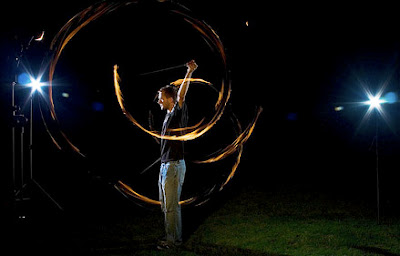For some shooters that can get a little complicated, but it doesn't need to be. More after the jump.
___________________
The Movement Is Your Shutter
The first step in balancing lights-in-motion with flash is to realize that moving light sources are very much like flash, in that their exposure is aperture-dependent. Take the fire juggling photo above for instance, which is by reader Hugh Beauchamp.
The fire in this photo is continuous, so its exposure is determined by both shutter and aperture. But since the continuous light source itself is moving, the speed at which it is moving already determines the effective shutter speed for a given place in the photo.
The faster it is moving, the less time the fire spends on any one spot on the frame to burn itself in, so to speak. So the speed of the motion of the flame is, in effect, it's shutter speed. Assuming a reasonably constant speed, the total exposure is now going to depend on the aperture. (It'll also depend on the ISO, of course, but let's zero that out for the sake of simplicity.)
Let's assume a dark environment. To duplicate the technique of Hugh's spinning fire shot, the process would simply be this:
1. Set your camera to a reasonable ISO. Say, ISO 200, for example. Lock down in a tripod.
2. Get your subject to run through the motion at normal speed as you shoot a few test exposures.
3. Varying the aperture and chimp the back of the camera until you like the look of the burned-in flames.
Now, you have your working aperture, and your shutter is going to be determined by how long and complicated you want the fire "tracks" to be. In this case, Hugh shot at f/10, for 1 second. (He was shooting at ISO 100.)
Now that you have a working aperture, it is a simple thing to adjust your flashes until you get the level of light that you want on your subject. Given that Hugh was shooting against a dark background, he wisely chose to use back/rim lighting to define his subject. This gave him dramatic light (which worked well with the fire) and good internal separation of his tones.
Hugh also chose to include his flash in this photo, which I like. He could have killed the light stand very easily by running a strip of matte-black gaffer tape down the front pole and legs, but now I am just being picky.

You can see Hugh's full lighting setup here, which is basically back/rim lighting plus a CTO'd flash for the face.
You might be thinking it would have been cool to do this at twilight instead of at night, But that's gonna make the whole thing more complicated, as now you have to worry about the sky "burning in" through parts of the juggler as he moves. Not to say that it can't be done. Just gets a little more complex as now you have to worry about your background tracking in various parts of the frame.
Cool shot, Hugh. And for those of you thinking of trying it: Please make sure you have a couple of buckets of water on hand. And resist the urge to keep shooting -- no matter how cool it looks -- if the whole field goes up in flames.
(You can see Hugh's whole combustible set of photos here.)
No comments:
Post a Comment